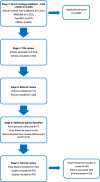The development, implementation and evaluation of interventions to reduce workplace sitting: a qualitative systematic review and evidence-based operational framework
- PMID: 29973188
- PMCID: PMC6033205
- DOI: 10.1186/s12889-018-5768-z
The development, implementation and evaluation of interventions to reduce workplace sitting: a qualitative systematic review and evidence-based operational framework
Abstract
Background: Prolonged sitting is associated with increased risks of cardiovascular disease, Type 2 diabetes, some cancers, musculoskeletal disorders and premature mortality. Workplaces contribute to a large proportion of daily sitting time, particularly among office-based workers. Interventions to reduce workplace sitting therefore represent important public health initiatives. Previous systematic reviews suggest such interventions can be effective but have reported wide variations. Further, there is uncertainty as to whether effectiveness in controlled trials can be replicated when implemented outside the research setting. The aims of this review are to identify factors important for the implementation of workplace sitting interventions and to translate these findings into a useful operational framework to support the future implementation of such interventions.
Methods: A qualitative systematic review was conducted. Four health and social science databases were searched for studies set in the workplace, with office-based employees and with the primary aim of reducing workplace sitting. Extracted data were primarily from author descriptions of interventions and their implementation. Inductive thematic analysis and synthesis was undertaken.
Results: Forty studies met the inclusion criteria. Nine descriptive themes were identified from which emerged three higher-order analytical themes, which related to the development, implementation and evaluation of workplace sitting interventions. Key findings included: the importance of grounding interventions in theory; utilising participative approaches during intervention development and implementation; and conducting comprehensive process and outcome evaluations. There was a general under-reporting of information relating to the context within which workplace sitting interventions were implemented, such as details of local organisation processes and structures, as well as the wider political and economic landscape, which if present would aid the translation of knowledge into "real-world" settings.
Conclusions: These findings provided the basis for an operational framework, which is a representation of all nine descriptive themes and three higher-order analytical themes, to support workplace sitting intervention development, implementation and evaluation. Once tested and refined, this framework has the potential to be incorporated into a practical toolkit, which could be used by a range of organisations to develop, implement and evaluate their own interventions to reduce workplace sitting time amongst staff.
Keywords: Evaluation; Framework; Implementation; Intervention development; Occupation; Qualitative systematic review; Sedentary behaviour; Sitting time; Workplace.
Conflict of interest statement
Authors’ information
KM is funded by a Doctoral Research Fellowship (DRF) from the National Institute for Health Research. This systematic review is part of the first phase of the DRF. She now intends to use the findings from this review in future phases of her DRF which will include the development, implementation and evaluation of interventions to reduce workplace sitting in four different organisations.
ES, PN and EG are all supervising this DRF.
Ethics approval and consent to participate
Not applicable.
Consent for publication
Not applicable.
Competing interests
The authors declare that they have no competing interests.
Publisher’s Note
Springer Nature remains neutral with regard to jurisdictional claims in published maps and institutional affiliations.
Figures
Similar articles
-
Interventions to support the resilience and mental health of frontline health and social care professionals during and after a disease outbreak, epidemic or pandemic: a mixed methods systematic review.Cochrane Database Syst Rev. 2020 Nov 5;11(11):CD013779. doi: 10.1002/14651858.CD013779. Cochrane Database Syst Rev. 2020. PMID: 33150970 Free PMC article.
-
Sitting less at work: a qualitative study of barriers and enablers in organisations of different size and sector.BMC Public Health. 2019 Jul 4;19(1):884. doi: 10.1186/s12889-019-7148-8. BMC Public Health. 2019. PMID: 31272484 Free PMC article.
-
Perceptions of the acceptability and feasibility of reducing occupational sitting: review and thematic synthesis.Int J Behav Nutr Phys Act. 2018 Sep 18;15(1):90. doi: 10.1186/s12966-018-0718-9. Int J Behav Nutr Phys Act. 2018. PMID: 30227861 Free PMC article. Review.
-
Interventions outside the workplace for reducing sedentary behaviour in adults under 60 years of age.Cochrane Database Syst Rev. 2020 Jul 17;7(7):CD012554. doi: 10.1002/14651858.CD012554.pub2. Cochrane Database Syst Rev. 2020. PMID: 32678471 Free PMC article.
-
Strategies to improve the implementation of workplace-based policies or practices targeting tobacco, alcohol, diet, physical activity and obesity.Cochrane Database Syst Rev. 2018 Nov 14;11(11):CD012439. doi: 10.1002/14651858.CD012439.pub2. Cochrane Database Syst Rev. 2018. PMID: 30480770 Free PMC article.
Cited by
-
What does it mean to conduct participatory research with Indigenous peoples? A lexical review.BMC Public Health. 2019 Oct 29;19(1):1388. doi: 10.1186/s12889-019-7494-6. BMC Public Health. 2019. PMID: 31660911 Free PMC article. Review.
-
"Oh-oh, the others are standing up... I better do the same". Mixed-method evaluation of the implementation process of 'Take a Stand!' - a cluster randomized controlled trial of a multicomponent intervention to reduce sitting time among office workers.BMC Public Health. 2020 Aug 8;20(1):1209. doi: 10.1186/s12889-020-09226-y. BMC Public Health. 2020. PMID: 32770969 Free PMC article. Clinical Trial.
-
Stakeholder perceptions of lethal means safety counseling: A qualitative systematic review.Front Psychiatry. 2022 Oct 20;13:993415. doi: 10.3389/fpsyt.2022.993415. eCollection 2022. Front Psychiatry. 2022. PMID: 36339871 Free PMC article.
-
Understanding the Implementation of "Sit Less at Work" Interventions in Three Organisations: A Mixed Methods Process Evaluation.Int J Environ Res Public Health. 2021 Jul 9;18(14):7361. doi: 10.3390/ijerph18147361. Int J Environ Res Public Health. 2021. PMID: 34299816 Free PMC article.
-
Using Co-Production to Develop "Sit Less at Work" Interventions in a Range of Organisations.Int J Environ Res Public Health. 2021 Jul 22;18(15):7751. doi: 10.3390/ijerph18157751. Int J Environ Res Public Health. 2021. PMID: 34360045 Free PMC article.
References
Publication types
MeSH terms
Grants and funding
LinkOut - more resources
Full Text Sources
Other Literature Sources
Miscellaneous



